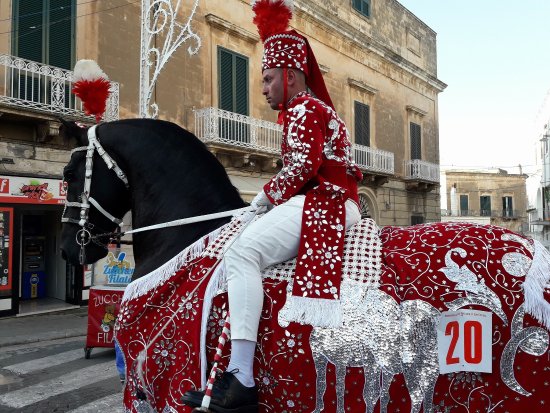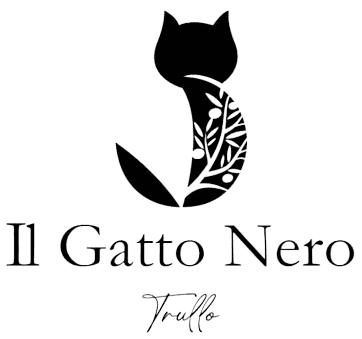Luogo:
Ostuni
Data:
25 – 26 – 27 Agosto
The cavalcade of sant’Oronzo is the most awaited and important festival in Ostuni. Every year on the 25th, 26th and 27th of August, are days dedicated to the saint: a procession of horses and knights dressed for a feast, parades through the city streets escorting the protector of the city. The origins of the ride were uncertain until a few years ago. Today they can be traced back, with a good safety margin, to the second half of the seventeenth century, precisely to 1657. The plague invaded Salento, sparing Ostuni and other cities of Terra d’Otranto. The miracle was attributed to Saint Oronzo and every 26 August the people of Ostuni wanted to go in procession to the sanctuary erected in his honor. There they took the papier-mâché statue depicting the saint, and carried it on their shoulders in the town square. Often the decorations are handed down from generation to generation as well as the gestures and the little indispensable secrets. The whole family is dedicated to dressing, often helped by relatives and friends. One of the most important decorations is the beautiful arabesque cloak with hundreds of sequins applied one by one with painstaking patience. The dressing continues with harnesses and friezes of various types and sizes. The knight also wears the uniform consisting of a kepi and a tunic that recalls the motifs of the horse’s cloak and white trousers. The dressing of the knight is also very accurate and in some respects recalls that of the bullfighter. The last details, the white gloves, the whip and here horse and rider become one entity. Our rider with his mount, like all the others, starts towards the meeting point, Piazza Cattedrale, climbing along the homonymous climb. Once in the cathedral square, horses and riders wait for the statue of St. Oronzo to be taken out of the mother church.
Until recently, it was believed that it was a rich lord of Ostuni, Don Pietro Sansone, who commissioned the construction of the silver statue which took place in 1788 in Naples, his city of origin. Recent and more in-depth research conducted by the local historian Luigi Greco, have made it possible to establish that the initiative was not taken personally by Pietro Sansone, as had always been believed, but by the Vatican, a sort of “couriers” of the time , who transported the goods on horse-drawn wagons. The Vatican, devoted to their patron like all Ostuni, made an agreement with their employer: they would set aside part of the earnings due to them, until they reached the sum of 4,000 ducats necessary for the construction of the statue. Luca Baccaro, a Neapolitan artist, was commissioned for the execution of the work. At the head of the 43 Ostunesi, many of whom were Vatican, there was another notary, Felice Giovine. Their intention was to set up an association of volunteers who would bear the expenses to best honor St. Oronzo. When the statue arrived in Ostuni, it was escorted on horseback by the Vatican which, thanks to their diligent work, contributed to the economic growth that characterized the second half of the eighteenth century. In fact, in previous years, for various reasons, the event had gradually become impoverished, so that it even risked not being held anymore. So those 43 citizens pledged to personally support all the necessary expenses, at the rate of 6 ducats a year each, for a total of 258 ducats to be spent on music, fireworks and whatever else was needed for the worthy success. of the event. The same subsidiaries would have formed the group of knights to escort the saint.
Over the years, therefore, this new social class, the bourgeoisie, had taken the place of the now decadent Ostuni aristocracy, whose members originally also participated in the procession, but on horseback to distinguish themselves from the common people. The statue is preceded by the bishop with the prelates of the diocese, and by the authorities. The procession opens with a trio of players who perform an ancient refrain accompanied by a fife and drums. At the end of the statue, the traditional band precedes the knights who often perform pirouettes, as in ancient times it was customary to advance the horses, performing in suggestive choreography. The Cavalcade of Sant’Oronzo, in its current configuration, began in 1803. In reality, the correct definition is ‘Cavalcade of the Devotees’. This naming is due to a group of citizens who, on August 26 of that year, went to the house of the notary Giuseppe Gaetano Tanzarella. The simulacrum leaves the beautiful Cathedral built in the second half of the 15th century, at the expense and with the labor of the Ostuni. Over time, the silver statue has taken the place of the papier-mâché one. It is therefore legitimate to argue that the Cavalcade of the Devotees, now known as the cavalcade of Saint Oronzo, has reached the present day, with inevitable changes but unchanged in substance, right from the beginning of the last century. At the end of the Cavalcata, the performance of operatic and symphonic pieces in piazza della Libertà, in the frame of the inevitable illuminations, is a must. The intense day concludes with the fireworks which, we like to think, the 43 devotees who, on that distant 26 August 1803, ensured the continuity of this extraordinary event in Ostuni, are also satisfied.



Leave a Reply